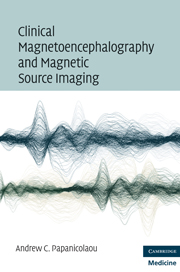Book contents
- Frontmatter
- Contents
- Contributors
- Preface
- Section 1 The method
- 1 Basic concepts
- 2 The nature and origin of magnetic signals
- 3 Recording the magnetic flux
- 4 Overview of MSI using the single equivalent current dipole (ECD) model as an example
- 5 The fundamental problems of MSI
- 6 Head models
- 7 Source models – discrete source models
- 8 Source models – distributed source models
- 9 Source models – beamformers
- 10 Pragmatic features of the clinical use of MEG/MSI
- Section 2 Spontaneous brain activity
- Section 3 Evoked magnetic fields
- Postscript: Future applications of clinical MEG
- References
- Index
6 - Head models
from Section 1 - The method
Published online by Cambridge University Press: 01 March 2010
- Frontmatter
- Contents
- Contributors
- Preface
- Section 1 The method
- 1 Basic concepts
- 2 The nature and origin of magnetic signals
- 3 Recording the magnetic flux
- 4 Overview of MSI using the single equivalent current dipole (ECD) model as an example
- 5 The fundamental problems of MSI
- 6 Head models
- 7 Source models – discrete source models
- 8 Source models – distributed source models
- 9 Source models – beamformers
- 10 Pragmatic features of the clinical use of MEG/MSI
- Section 2 Spontaneous brain activity
- Section 3 Evoked magnetic fields
- Postscript: Future applications of clinical MEG
- References
- Index
Summary
Head models attempt to capture the geometry and distribution of electrical conductivity within actual heads. Knowledge of these detailed conductivity characteristics is necessary for solution of the forward problem because both the primary current (i.e., the current flowing within the active cells) and the secondary or volume currents (i.e., the return currents through the rest of the head that are required by charge conservation) jointly account for the recorded magnetic field. In practice, however, approximations are used, with volume conductors of varying complexity serving as models of the head. The adoption of different geometries and conductivities results in solutions with different inherent errors, and the choice of an appropriate head model involves trade-offs in accuracy, computational efficiency, and ease of use. The following classes of such models, in increasing order of flexibility and realism, have been developed: spherical or spherically symmetrical models, boundary element models (BEMs), finite difference models (FDMs), and finite element models (FEMs). Figure 6.1 summarizes the various head models that have appeared in the literature over the past several years.
Spherical models
Most clinical MEG applications use sphere or multisphere models, since they can be generated and solved very efficiently and are sufficiently accurate for most clinical purposes. By using external head measurements or structural-imaging data (e.g., MRI), a best-fitting sphere is found that approximates the head (or inner skull) shape. A sphere model assumes that the head can be represented as one – or a set of – concentric spheres, i.e., the head is assumed to be radially symmetrical (see Fig. 6.2).
- Type
- Chapter
- Information
- Publisher: Cambridge University PressPrint publication year: 2009



